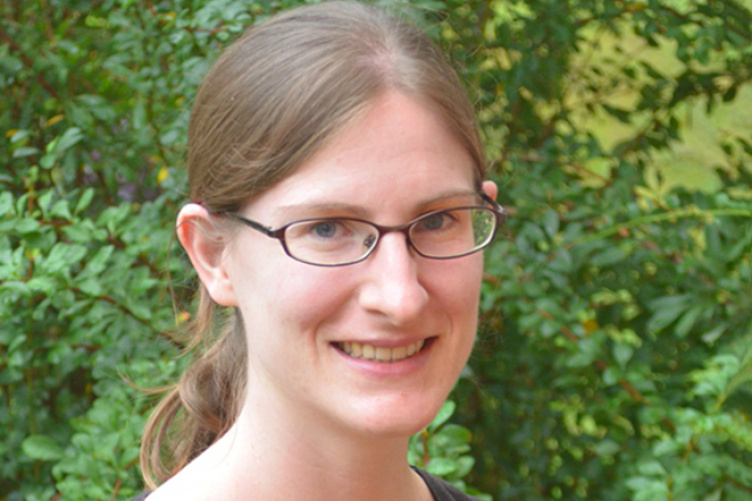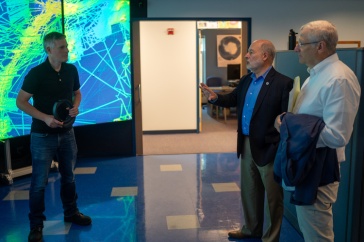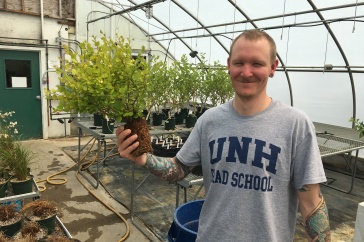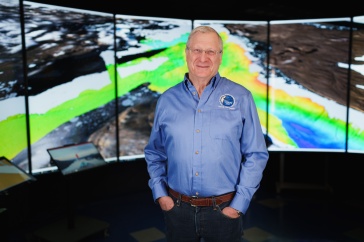
UNH Ph.D. candidate Danielle Grogan's scientific career was cemented by her undergraduate research experience at Smith College, where she majored in mathematics and minored in geology. Her research project involved a little campus pond that perpetually filled with silt and had to be dredged every few years. Grogan was tasked with figuring out why, and thereafter was hooked on the hydrologic-human cycle.
“That was my first experience where the scientific data I collected had a direct impact on people making decisions about the hydrologic system and how to manage water,” says Grogan. The research resulted in the college and town of Northampton, Mass, receiving a state grant “to try and improve the whole town’s sewage and drainage system because we found most of the sediment was coming through drainage pipes.”
Ever since then, water has been the constant theme through Grogan’s academic career, which included a master’s in paleoclimatology from Brown University that focused on hydrological processes of the past. With the hydrologic-human connection having been forged by her undergraduate experience, three years into her doctoral work at UNH she is blending her expertise in hydrologic modeling with social science and economics on a number of projects.
"I’m interested in the interactions between hydrology and people in terms of agriculture, urban development and climate change,” says Grogan. “Water is such a basic, fundamental thing in our lives — from how we grow our food to how we run our cities. We interact with it all the time and don’t always realize it, and studying hydrology is a great way to get into the connections between science and people.”
Last summer, Grogan spent 10 weeks studying in Japan on a summer research fellowship from the National Science Foundation’s East Asia and Pacific Summer Institutes for U.S. Graduate Students program. She worked with researchers at the University of Tokyo’s Global Hydrology and Water Resources Engineering Lab, directed by world-renowned hydrologist Taikan Oki. The Japan Society for the Promotion of Science jointly sponsored the fellowship.
 For this project, Grogan is using two existing hydrologic models — UNH’s Water Balance Model developed by the Water Systems Analysis Group (WSAG) over a period of decades — and the University of Tokyo’s Catchment-based Macro-scale Floodplain model. The combined modeling will address a specific set of research questions: How does changing land use from forest to agriculture alter flood risks; how does this compare to flood risks due to urbanization, and how will climate change increase or alleviate these risks?
For this project, Grogan is using two existing hydrologic models — UNH’s Water Balance Model developed by the Water Systems Analysis Group (WSAG) over a period of decades — and the University of Tokyo’s Catchment-based Macro-scale Floodplain model. The combined modeling will address a specific set of research questions: How does changing land use from forest to agriculture alter flood risks; how does this compare to flood risks due to urbanization, and how will climate change increase or alleviate these risks?
Crops, climate, canals and the cryosphere
The fellowship grew out of Grogan’s involvement in an NSF-funded project led by UNH Earth Systems Research Center biogeochemical modeler Steve Frolking. The project, titled “Crops, Climate, Canals and the Cryosphere in Asia; Changing Water Resources Around the Earth’s Third Pole,” is part of NSF’s Water Sustainability and Climate program. ESRC’s Changsheng Li, Richard Lammers and Dominik Wisser are also on the project.
The Third Pole is the 2.5 million square kilometer Tibetan Plateau, and the $1.5 million multidisciplinary, multi-institution study is an assessment of current and projected water resources in the watersheds of the region’s major rivers, principally the Indus, Ganges, Brahmaputra, Salween, Mekong, Yangtze, Yellow, Amu Darya, Syr Darya and Irtysh. Grogan has used the Water Balance Model to estimate how much food is produced in China as a direct result of irrigation systems that use mined groundwater.
Grogan says that the Third Pole project doesn’t concern flooding, but a lot of the people in WSAG she works with are on the NSF-funded NH EPSCoR (Experimental Program to Stimulate Competitive Research) project doing hydrology modeling and focusing on the interaction between human systems and hydrology in the context of climate change.

“I basically went to Japan to learn how to do the flooding component of hydrology modeling and apply it to the EPSCoR ‘Ecosystems and Society’ project, as well as add this capability to our group’s modeling efforts. The Water Balance Model does stream flow, soil moisture, evaporation, all these aspects of the hydrologic cycle, but we have not yet done any type of flood representation,” Grogan says.
Before her 10 weeks in Japan, Grogan wasn’t sure if she would end up using the flood model as a separate tool that would be paired with the Water Balance Model or if she would completely merge the two by recoding the flood model into the UNH model.
“I’ve concluded that I will recode the flood model into the Water Balance Model. I am also very confident that the flood model will apply to the EPSCoR project,” Grogan says. Alex Prusevich, a member of WSAG, is also involved in re-coding the flood model.
Freedom through funding
Grogan notes that she was able to “sort of attach myself” to the EPSCoR project because she’s had additional funding through the NSF Graduate Research Fellowship Program that has allowed her the freedom to participate in multiple projects as they fit into her dissertation.
 “I knew flooding aspects were something the EPSCoR researchers want to do. Shannon Rogers at Plymouth State is one of the natural resource economists on the project, and she’s very interested in the results from a flood study in terms of the economic side of it and what it might mean to stakeholders.” Grogan adds, “There are some ways we’ve proposed or thought about estimating flooding with our Water Balance Model, but it’s not as sophisticated as the model I learned in Tokyo.”
“I knew flooding aspects were something the EPSCoR researchers want to do. Shannon Rogers at Plymouth State is one of the natural resource economists on the project, and she’s very interested in the results from a flood study in terms of the economic side of it and what it might mean to stakeholders.” Grogan adds, “There are some ways we’ve proposed or thought about estimating flooding with our Water Balance Model, but it’s not as sophisticated as the model I learned in Tokyo.”
The UNH Water Balance Model represents the basic dynamics of the hydrologic cycle and moves a known quantity of water from point A to point B. The flood model can show not only if a flood occurs, which the UNH model can also do, but also what the spatial extent of the flooding is and how deep the flood waters are at different places in the floodplain.
“In the UNH model, the water is always going in one direction, downstream,” Grogan notes, “but once you start flooding you create eddies and it’s a more complex representation of water flow. The flood model has the ability to model water backflow.”
Grogan hopes to take the modeling work she began in Japan and apply it to what flooding would look like in the EPSCoR project domain under different climate change and land-use scenarios. Developing a suite of scenarios that project into the future is a critical component of the Ecosystems and Society work. These scenarios will provide plausible "storylines" on how land cover and climate might change across N.H. over the course of 50 years.
“What might development or urban areas look like under these scenarios, where will there be agriculture, what will the forests look like? I want to take those scenarios, put them into the model, and translate that into what floods will look like,” Grogan says. “I’ll do this especially with regards to where deforestation occurs because there’s a connection between the land cover — such as forest versus agriculture — and how much water ends up in a river and how that leads to flooding, and that might indicate what areas might be important for conservation if the goal is to prevent or reduce flooding.”
Merging physical and social sciences
At the heart of the Ecosystems and Society and Third Pole projects is the merger of physical and social sciences in an effort to study the big picture and produce research results that impact society. Both projects involve physical scientists and economists working towards the same end — new and challenging territory that Grogan is directly involved in through her work with economists at Penn State, which is also a partner institution in the Third Pole project.
“It’s been really interesting working with the economists at Penn State and seeing how these two very different fields that have totally different vocabularies and world views come together to answer questions we really couldn’t answer if we each worked on our own,” Grogan says.
She adds, “We generally think of economists as only concerned with money, but I’ve been working with one who does econometrics — very sophisticated statistical analysis of data, a way of understanding how people make their decisions about, for example, irrigation water use. In some way there’s this physical linkage between the econometric output data and what I put into my model, but in order to get to that point we had to do a lot of work just to understand each other. Now, we’re doing research together and actively running the model and looking at output.”
When she wraps up her Ph.D. in the next year or two, Grogan will carry on with her focus on modeling since, as a self-described “very quantitative person,” she likes the idea that she can ask questions and test hypotheses in the model world that couldn’t be done in the real world.
“We can run so many imaginative scenarios with a model; what happens when you cut down all the forests or double temperatures really fast? As a scientist, I like having that control.”
On a personal level, Grogan notes, the best part of her experience in Japan was meeting other students and researchers from a variety of disciplines and countries. “I met researchers from not only Japan, but Malaysia, the Philippines, Korea, Pakistan, Nepal, India, Germany, Switzerland, the U.K. and France, and I will keep in touch with some of them both personally and professionally.”
She adds that her time in Japan was more challenging than expected and gave her a new level of respect for foreign students who come to the U.S. to study and conduct research.
“Unlike an undergraduate study abroad program, I was the only American in the Tokyo Water Resources Lab, and often the only person in any given gathering who did not speak Japanese. I really had to be more outgoing than I usually am in order to get to know people and to allow them to feel comfortable speaking English with me.”
Originally published by:
The UNH Institute for the Study of Earth, Oceans, and Space Spheres newsletter
-
Written By:
Tracey Bentley | Communications and Public Affairs



















































